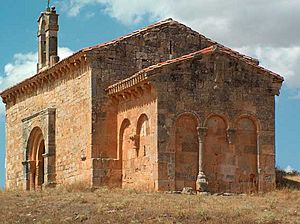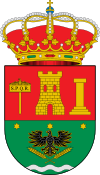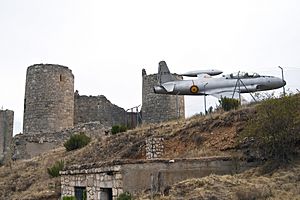Coruña del Conde facts for kids
Quick facts for kids
Coruña del Conde
|
||
|---|---|---|
|
Municipality and town
|
||

Hermitage of Santo Cristo de San Sebastián (11th or 12th century). Its square apse is of Visigothic origin.
|
||
|
||
| Country | Spain | |
| Autonomous community | ||
| Province | ||
| Comarca | Ribera del Duero | |
| Area | ||
| • Total | 32 km2 (12 sq mi) | |
| Elevation | 903 m (2,963 ft) | |
| Population
(2018)
|
||
| • Total | 112 | |
| • Density | 3.50/km2 (9.06/sq mi) | |
| Time zone | UTC+1 (CET) | |
| • Summer (DST) | UTC+2 (CEST) | |
| Postal code |
09410
|
|
Coruña del Conde is a small village and municipality (a type of local government area) in the province of Burgos, located in the region of Castile and León in Spain. The Arandilla River flows through this historic area.
This charming village is home to the ruins of an ancient Muslim castle. This castle sits on a hill, watching over the town. It was later used by counts from the Kingdom of Castile, an old kingdom in Spain. Coruña del Conde also has a beautiful Romanesque chapel called Santo Cristo.
The village is famous for a big claim in history: it says the first human flight happened here! This was supposedly done by an air pioneer named Diego Marín Aguilera, who was born in Coruña del Conde. To remember this claim, the Spanish Air Force placed a model plane near the castle.
Coruña del Conde is also close to the ancient Roman city of Colonia Clunia Sulpicia. This was once a very important city in Roman Spain.
Coruña del Conde: A Historic Spanish Village
Coruña del Conde is a place full of history, from ancient Roman times to the early days of flight. It's a quiet village today, but its past is very rich. The village is a great example of how old buildings and stories can still be a big part of a community.
The Ancient Castle
The most striking landmark in Coruña del Conde is its old castle. It was first built by Muslims many centuries ago. Later, it was taken over and used by the Christian counts of the Kingdom of Castile. The castle's ruins stand proudly on a hill. From there, you can see the whole village and the surrounding countryside. It reminds everyone of the many battles and changes that happened in this part of Spain long ago.
Roman Roots: Clunia Sulpicia
Just 2 kilometers from Coruña del Conde are the remains of Colonia Clunia Sulpicia. This was one of the most important Roman cities in ancient Spain, known as Hispania. A very famous event happened here: Emperor Galba was declared emperor by his soldiers. From Clunia, he then marched to Rome to take power.
Many of the stones from this ancient Roman city were later used to build other structures in the area. You can find these old Roman stones in churches, arches, walls, and even castles and palaces in nearby towns like Peñaranda de Duero. This shows how important Clunia was and how its legacy lived on.
The Romanesque Chapel
Coruña del Conde is also home to the Romanesque chapel of Santo Cristo. Romanesque style is an old way of building, popular in Europe between the 11th and 12th centuries. These buildings often have thick walls, round arches, and strong, simple designs. The chapel is a beautiful example of this ancient architecture. It has been a place of worship for centuries.
Diego Marín Aguilera: The First Flight?
One of the most interesting stories from Coruña del Conde involves Diego Marín Aguilera. He was born in the village in 1757. People in Coruña del Conde believe he was the first person to achieve human flight! The story says that in 1793, he built a flying machine. He supposedly flew it for a short distance from the castle walls. While this claim is debated by historians, it's a proud part of the village's heritage. The plane placed by the castle is a tribute to his pioneering spirit.
Other Notable People
Besides Diego Marín Aguilera, Coruña del Conde was also the birthplace of Bishop Agustín. He became a bishop in Popayán, a city in Colombia. This shows that even a small village can be the starting point for people who go on to achieve great things far away.
See also
 In Spanish: Coruña del Conde para niños
In Spanish: Coruña del Conde para niños




